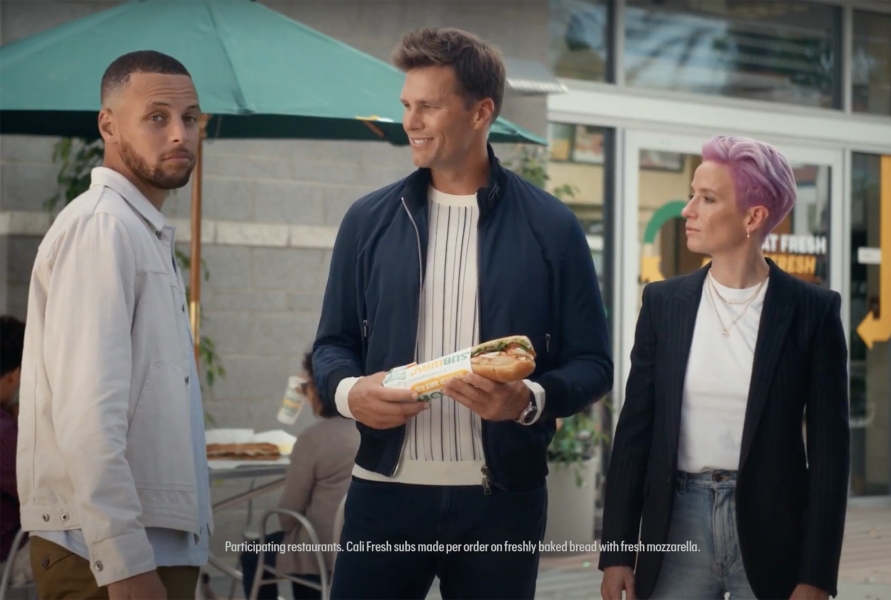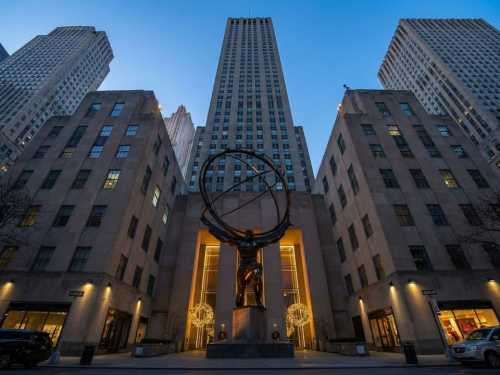
Close your eyes and imagine the last time you were inside a Subway. Do you see the dated storefront? The fluorescent lighting? Do you catch a whiff of that unmistakable, disturbingly sweet bread smell? Maybe there’s a group of high school kids snarfing down their subs after school. Yet, this is the very same chain that has, in recent years, attracted some of the world’s biggest and highly-coveted athletes to playfully hawk its sandwiches in a barrage of TV ads: Tom Brady, Steph Curry, Serena Williams, Simone Biles, Travis Kelce and Patrick Mahomes — the list goes on.
The message Subway is going for is clear. Strong, fit athletes love their food. Subway is healthy — or, at least, healthier than the other fast food options you might have been considering for lunch. The slogan it has returned to, after all these years, is to “Eat Fresh.”
“The ads drive you into a restaurant that looks and feels like the ’90s,” says Barry Thomas, a senior global thought leader at market research firm Kantar. It’s currently trying to remodel for a more modern look, though only about half of its stores have been renovated. Subway’s flashy marketing only underscores this disconnect.
Subway has been famous for a lot of things over its 56-year history: The fan-favorite $5 footlong (RIP), smirking complaints that, actually, its footlong isn’t quite 12 inches, and the scandal of their former brand spokesperson Jared Fogle being convicted on charges related to child sexual abuse. Less well-known is how it has struggled to regain its perch as the King of Subs in the past decade. Over the last few years, Subway has pulled out all the stops and seemingly poured millions of dollars for an expensive ad campaign that would refresh its image and revive flagging sales.
“For the last three years, Subway has been on a transformation journey to deliver better food and a better guest experience through ongoing menu and digital innovation and restaurant modernization,” a company spokesperson told Vox in an email. “Subway’s initiatives are paying off and the company is a remarkably different brand than it was when we began our transformation journey. As we continue to listen to our franchisees and exceed guests’ expectations, our growth journey is far from over.”
But the problems plaguing the chain haven’t gone away yet: It still has too many stores, it’s still feeling squeezed in a competitive fast food scene that can offer both cheaper or healthier fare, and the relationship it has with its army of franchisees, who have largely paid the price for the chain’s zealous overexpansion and glitzy ad blitz, is still tense. Here’s how it got here.
Marketing versus reality
Subway hasn’t disclosed how much money it spent on its star-studded ad campaign, which rolled out in 2021 as part of an overall push to revamp its brand, called the Eat Fresh Refresh. It included a new menu, new ingredients, even new bread, including a low-carb version — understandable moves for a company that’s been sued for not using real tuna in their sandwiches (the lawsuit was dismissed), and whose bread was once deemed too high in sugar to be called bread by an Irish court.
Andrew Stallings, founder of athlete marketing agency Athelo Group, says that pay structures for athlete brand deals can vary, from a flat fee to equity in a franchise. But one point of comparison is LeBron James’s endorsement deal with McDonald’s, which began in 2010 and reportedly paid the basketball star about $4 million a year. Mollie Partesotti, chief strategy officer at the ad agency FCB Chicago, estimates that each big name Subway has hired is getting somewhere around seven figures, depending on the athlete. “I would say Patrick Mahomes is probably getting $2 million to $5 million,” she tells Vox.
In short, Subway has tapped “the most expensive restaurant marketing personalities there are,” Thomas says.
Marketing itself as a healthier option — whatever that means — and using athletes to promote that message is not new for Subway. The company long positioned itself as the healthy oddball among fast food fare dating back to an era when people weren’t ordering build-your-own salad bowls. The company ran a lot of ads in the 1990s driving home this point, explicitly comparing itself to McDonald’s and Burger King.
Thomas notes that famed former Subway Chief Marketing Officer Tony Pace started using athletes to promote Subway over a decade ago. “He came out swinging, I mean swinging, with huge ad dollars and really tripling down on health and their Famous Fan campaign,” recalls Thomas. In TV spots and press releases, athletes like Blake Griffin and Michael Phelps would talk about how much they enjoyed eating Subway, especially because they needed the fuel and nutrition in their physically intense line of work. Those ads rang true, Thomas argues, partly because it was a vastly different time.
“Steph Curry hawking the meat slicer feels a little, you know, corporate.”
Today, the cultural attitude around what’s “healthy” food has shifted so much — gym rats steadfastly count their macros, avoid carbs like the plague, and take so many questionable supplements — that it’s difficult to imagine a giant sub fitting the bill. It’s that much harder for Subway to sell health. Fast casual chains Sweetgreen and Cava have exploded in popularity in recent years, and even Chick-fil-A now offers fruit cups and salads as sides. The athlete endorsements ring a little less authentic, too. “They feel very much like paid endorsements,” says Partesotti. It’s one thing for Cardi B and Offset to plug their favorite McDonald’s order — it plays up the idea that celebrities are just like us, occasionally indulging in a delicious if unhealthy meal. It’s another for Steph Curry to tell us that Subway now slices its deli meat in-house, of all things. These are athletes who likely adhere to an extremely strict meal plan. “Steph Curry hawking the meat slicer feels a little, you know, corporate,” says Partesotti.
Pro athletes endorsing Subway, for their part, could simply be following the precedent Subway established in older ad campaigns — that they’re healthier than burgers, that sports stars love their food. Plus, the money doesn’t hurt. The biggest sports stars earn the bulk of their wealth through endorsement deals and other ads rather than the salary they get from, you know, playing their sport (never forget Tom Brady’s ill-advised FTX endorsement, for which he was reportedly paid $55 million).
Where Subway went wrong, and how it’s trying to fix things
Subway’s ability to snag such an exceptional roster of brand ambassadors stands in sharp contrast to the chain’s financial woes in recent years. Probably the biggest mistake Subway made over the past few decades, experts say, is growing way too big. About a decade ago, there were over 27,000 Subways in the US. You could visit one location and trip right over another one. Since then, it has closed about 7,000, and more closures continue to trickle in, but it still has more locations in the US than McDonald’s does (about 13,500 stores).
What makes Subway remarkable compared to other fast-food chains is that all of its stores are owned and operated by franchisees, versus some percentage being operated by the company. The draw of buying a Subway location is that it’s relatively cheap; the overall cost to start one is estimated to be between $229,050 to $522,300, much cheaper than the million-plus dollars it would take to open a McDonald’s franchise. The catch, though, is that Subway charges a king’s ransom from franchisees, who must tithe 12.5 percent of sales per week to HQ. McDonald’s rate is 5 percent.
Subway’s issues really came to a head in 2015, says Jonathan Maze, editor-in-chief of Restaurant Business. That was the year Jared Fogle, who had spent 15 years preaching that the Subway diet could help you lose weight, was arrested. Subway co-founder Fred DeLuca, who had dreamed of one day having 100,000 Subway stores, died and did not have a solid succession plan. Sales dipped from $12 billion annually in 2013 to $9.4 billion in 2021. Perhaps in a stir of cost-saving determination, the chain also said it would be moving away from celebrity athlete endorsements for a while in 2015, before returning to them again in recent years.
Another illuminating metric of Subway’s struggles is how much one store in a fast-food chain typically sells per year, known as the average unit volume, compared to other fast-food chains. By 2015, Subway’s AUV was reportedly around $425,000, according to data from food service consulting firm Technomic. Thanks to aggressive store closures and brand refresh efforts, that has ticked up to a little under $500,000 now, but that’s still “a paltry amount,” says Maze. McDonald’s sold about $4 million worth of food per store last year; Chick-fil-A’s per-store sales beat both, at $9 million.
Which raises the question again: How is Subway affording such a high-dollar ad campaign with the world’s most coveted athletes? In short, because its many, many franchisees are footing the bill. Part of the weekly 12.5 percent fee franchise owners pay Subway is an explicit “advertising fee” of 4.5 percent, which is almost as much as McDonald’s charges total to its franchisees. “They can afford [the ads],” says Maze.
“We can’t keep advertising Serena with the sandwich, if we just don’t deliver on the restaurant.”
Subway’s franchisees do benefit from flashy ads starring their favorite names in sports, but it’s hard not to wonder about the price tag of hiring superstars when they’re struggling to keep their stores afloat. “We can’t keep advertising Serena with the sandwich, if we just don’t deliver on the restaurant,” says Thomas.
“If you talk to a lot of franchisees at Subway who’ve been around for decades, they don’t like [the ads],” says Thomas. “They’re like, ‘I know we’re overpaying for that.’” It’s money that could be used to help franchisees remodel their stores more quickly. It’s money that could go toward reimbursing more of franchisees’ financial losses when Subway decides to offer a promotional deal that’s very appetizing to consumers, and not so enticing for store owners. Case in point: the hallowed $5 footlong, or the ongoing buy 1 footlong get 1 free deal that Subway pushes in order to get customers through the door, but which can leave individual store owners at risk of losing money (the North American Association of Subway Franchisees has gone so far as to hire an attorney to help them resolve these kinds of disputes with the company).
In its most recent revamp, the company has put some effort into making the experience of eating at a Subway feel more modern and health conscious. Its menu continues to get regularly updated with new offerings; it recently introduced wraps, but its menu of snacks includes a strange, very unwieldy-looking footlong cookie, as well as a footlong churro. Its redesigned stores — which it practically ordered franchisees to foot the bill for, although it did offer some $10,000 remodeling grants back in 2019 — have also adopted a more millennial aesthetic of decor, featuring bright green accent walls and digital kiosks. Unfortunately, only about half of its 20,000 locations have been updated. In addition, Subway reportedly spent about $80 million on the new meat slicers, which some franchisees complain aren’t driving sales.
Subway’s uncertain private equity future
For a long time, Subway was the biggest name in the sandwich game, but it occupies a strange place in the world of fast food now. There are a lot of sandwich chains these days offering high-quality subs, including Jimmy John’s, Jersey Mike’s, and Firehouse Subs. Subway’s brand perception has taken a bit of a tumble in recent years, especially compared to the early 2010s. According to YouGov, under a third of consumers said that they would consider eating at Subway post-pandemic. The same YouGov reports does note that its latest ads do seem to have helped somewhat, though not to the pre-pandemic levels of popularity.
It’s unclear how well Subway’s play to shrink itself will pan out. Its sales are improving, but still haven’t fully caught back up to the early 2010s levels. The biggest point of optimism, according to experts, might just be that the chain was recently bought by private equity firm Roark Capital for an eyebrow-raising $9.5 billion. The fact that Roark paid such a high price shows that they still saw a lot of value in the Subway name. Under Roark, it’s now part of a family of chains that include Auntie Anne’s, Dunkin’, Buffalo Wild Wings, and many more, including sandwich rival Jimmy John’s.
While private equity-owned restaurant chains have been in the news lately in light of Red Lobster’s bankruptcy, “franchisees were absolutely on board with the sale to Roark Capital,” Maze says. Thomas was also happy to see the sale to Roark, but believes that for Subway to really recover, it needs to pick what it’s going to stand for. Is it for health? Is it for value? Is it something else? The menu and store experience could still use more improvement.
Maze’s verdict is that it’s been a very bumpy road for Subway, but it’s doing better than it used to. That’s actually kind of high praise. “Jesus himself would probably need a couple of years to have fixed Subway from the problems it had created for itself,” he says.
Source: vox.com






